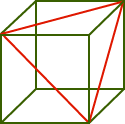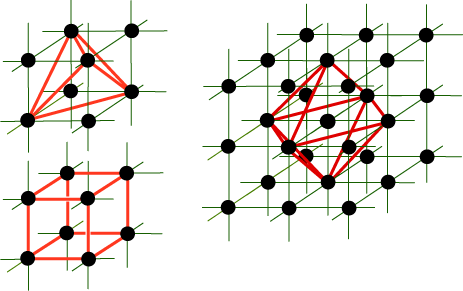|
5. REGULAR LATTICE POLYGONS
An equiangular polygon is one which has all angles the same size. Examples are the equilateral triangle and the rectangle. A regular polygon is a polygon which is equilateral and equiangular. Simple examples are the square and the equilateral triangle. In terms of lattice points, an obvious question to ask is: are there any equilateral, equiangular or regular (convex) lattice polygons? That is, are there any polygons of each type for which every vertex is a lattice point. What if the lattice is not the integer lattice, but for example the triangular lattice?
|
|||
|
If you have been very thorough, you might also have found the equilateral hexagon below!
Proof of the Equilateral and Regularity Theorems This proof is quite pretty, and is essentially the proof given by Ball. The proof is made up of a number of smaller steps. Theorem 1 If n is odd, then an equilateral n-gon cannot be constructed on the integer lattice. We shall need this preliminary result. Lemma If (integers) p and q are odd, then p2 + q2 is not divisible by 4. Proof Suppose first that p = 2m + 1, q = 2n + 1. Secondly, suppose p = 2m, q = 2n. Proof Theorem 1 Suppose that n is odd, and that an equilateral lattice n-gon is constructible. In this case, there will be such a polygon for which the sides have minimal length. Consider this one. u1 = (a1 , b1 ), u2 = (a2 , b2 ), u3 = (a3 , b3 ), ... , un = (an , bn ). Then a1 + a2 + a3 + ... + an = 0, (1) b1 + b2 + b3 + ... + bn = 0. (2) As well, if all the sides have length l, then a12 + b12 = a22 + b22 = ... = an2 + bn2 = l2. (3) Notice that l2 must be an integer. If we square (1) and (2) and add together, we obtain 0 = (a1 + a2 + a3 + ... + an)2 + (b1 + b2 + b3 + ... + bn)2 = (a12 + b12) + ... + (an2 + bn2) + 2(a1a2 + a1a3 + ... + a1an = nl2 + 2K (say) where K is the sum of the products of the as and the bs. So nl2 = – 2K (4) Now since n is assumed to be odd, by (4) l2 must be even. Hence from (3), each the coordinates of each pair (a1, b1), ... , (an, bn) are either both even or both odd. If l2 is divisible by 4, then from the Lemma, each of the ai, bi are both even, for each value of i. But this would mean that our polygon was not minimal, because there would be a similar polygon half the size. Hence l2 is not divisible by 4. So l2 must be divisible by 2, but not by 4, and from the Lemma, each of the ai, bi are both odd, for each value of i. Now looking at the definition of K, each of the contributing products is odd, and there is an even number of them (each a product has a corresponding b product). Therefore K must be even. So, the right hand side of (4) is divisible by 4, and since n is odd, this means that l2 is divisible by 4. We now have a contradiction. We conclude that for odd n, an equilateral lattice n-gon is not constructible. Corollary A regular lattice n-gon can only exist if n is even. Proof For if there was a regular lattice n-gon with odd n, that n-gon would be equilateral. We have shown that this is impossible.
Proof For if we could construct the larger n-gon, a subset of the polygon vertices would give us the smaller regular m-gon as a regular lattice polygon. Example In the figure, suppose we could construct the regular lattice hexagon (n = 6). Then taking every second polygon vertex, we generate the equilateral lattice triangle (m = 3). In general, we would expect to choose every n/m th vertex. Theorems 1 and 2 together tell us that it is not possible to construct a regular n-gon on the integer lattice if n has an odd factor. This leaves us with possible regular lattice polygons with 2k vertices. Theorem 3 It is not possible to construct a regular octagon on the integer lattice. Proof This is easy to prove, but we need a trigonometric formula. To find the angle between vectors (a, b) and (c, d) (from the origin, say), let the vectors make angles tan (
Finally, tan (3 From Theorems 2 and 3 we now deduce that no regular lattice polygon with 2k sides exists for k Regularity Theorem The only regular polygon with vertices in the integer lattice is the square. We have already observed that there are many different ways of placing such a square. This is rather a disappointing result! However we can now easily establish the following: Theorem 4 If n is even, then there exists an equilateral n-gon with vertices in the integer lattice. Notice that this theorem, along with Theorem 1 almost gives the Equilateral Theorem, Proof of Theorem 4 Consider the equilateral lattice hexagon and square at the right. By adjoining (copies of) these along a common edge, we can obtain non-convex lattice polygons with 8, 10, 12, ... edges – in fact, any even number of edges.
We might mention that an ingenious shorter proof of the Regularity Theorem was published (in German) by Scherrer [Sch] in 1946. An account in English is given in Hadwiger, Debrunner and Klee [HDK].
(1) Honsberger [H] looks at the equiangular case, and shows that there exists an equiangular polygon with vertices in the integer lattice if and only if n = 4 or n = 8. It is a simple matter to find lattice polygons which satisfy this condition. (2) We might ask similar questions about polygons having vertices in the (equilateral) triangular lattice. It is easy to see that a (regular) equilateral triangle and a regular hexagon can be constructed. Klamkin [K] asks for, and receives a proof that no lattice square exists with vertices belonging to an equilateral triangular lattice.
(4) Are there any regular lattice polyhedra in 3-space? Ehrhart [E] shows that is is not possible to embed a regular dodecahedron or icosahedron in a cubic lattice. However, it is easy to see that we can embed a regular tetrahedron, a cube, and an octahedron. Can you do it? Check. (5) A further thought along this lines is to ask whether there are any semiregular lattice polyhedra in 3-space. There are 13 semiregular polyhedra, but since any face of such a polyhedron must be a lattice polygon, by (2) we only need consider polyhedra whose faces are triangles, squares or hexagons. This leaves just five possibilities:
in order, the truncated tetrahedron, the truncated octahedron, the cuboctahedron, the rhombicuboctahedron and the snub cuboctahedron. Scott [S] shows that only the first three of these are possible. Notice that the rhombicuboctahedron is quickly ruled out because it contains lattice octagons. [B] Ball, D.G., Constructability of regular and equilateral polygons on square pinboards, Mathematical Gazette 57 (1973) 119 – 122. [E] Ehrhart, E., Sur les polygones et polyèderes réguliers entiers, L’Enseignement Mathématique 5 (1959) 81 – 85. [HDK] Hadwiger, H., Debrunner, H., Klee, V., Combinatorial geometry in the plane, Holt, Rinehart and Winston (1964). [H] Honsberger, R., Semiregular lattice polygons, Two Year College Mathematics Journal 13 (1982) 36 – 44. [K] Klamkin, M., Problem 709, Elemente der Mathematik 30 (1975) 14 – 15. [KC] Chrestenson, H. E., Polygon embedded in a lattice, American Mathematical Monthly 70 (1963) 447 – 448. [Sch] Scherrer, W., Die Enlagerung eines regularen Vielecks in ein Gitter, Elemente der Mathematik 1 (1946) 97 – 98. [S] Scott, P. R., Equiangular lattice polygons and semiregular lattice polyhedra, The College Mathematical Journal 18 (4) (1987) 301 – 306. |
||||
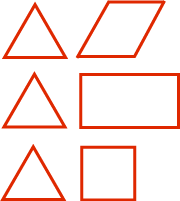 An equilateral polygon is one which has all sides of equal length. Examples are the equilateral triangle, and the rhombus.
An equilateral polygon is one which has all sides of equal length. Examples are the equilateral triangle, and the rhombus. As a result of your
As a result of your 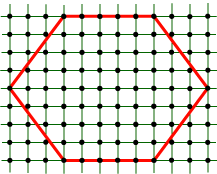
 [This is a not uncommon strategy in showing something is not true.]
[This is a not uncommon strategy in showing something is not true.] Theorem 2 Suppose it is not possible to construct a regular m-gon on the integer lattice. Then if n = km, it is not possible to construct a regular n-gon on the integer lattice either.
Theorem 2 Suppose it is not possible to construct a regular m-gon on the integer lattice. Then if n = km, it is not possible to construct a regular n-gon on the integer lattice either.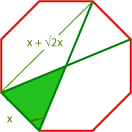 In fact, all we need from this is the observation that the tangent of any lattice angle is a rational number or fraction. Now suppose we have a regular lattice octagon (right). The green shaded isosceles triangle has vertex angle 2
In fact, all we need from this is the observation that the tangent of any lattice angle is a rational number or fraction. Now suppose we have a regular lattice octagon (right). The green shaded isosceles triangle has vertex angle 2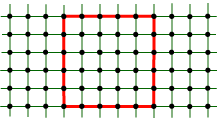
 Scherrer first disposes of the equilateral triangle case. Using the well-known determinant formula for the area of a triangle (right), he observes that a lattice triangle must have rational area. On the other hand, a equilateral triangle of sidelength s has area
Scherrer first disposes of the equilateral triangle case. Using the well-known determinant formula for the area of a triangle (right), he observes that a lattice triangle must have rational area. On the other hand, a equilateral triangle of sidelength s has area 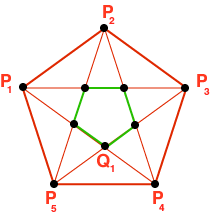 Now suppose that for n
Now suppose that for n 